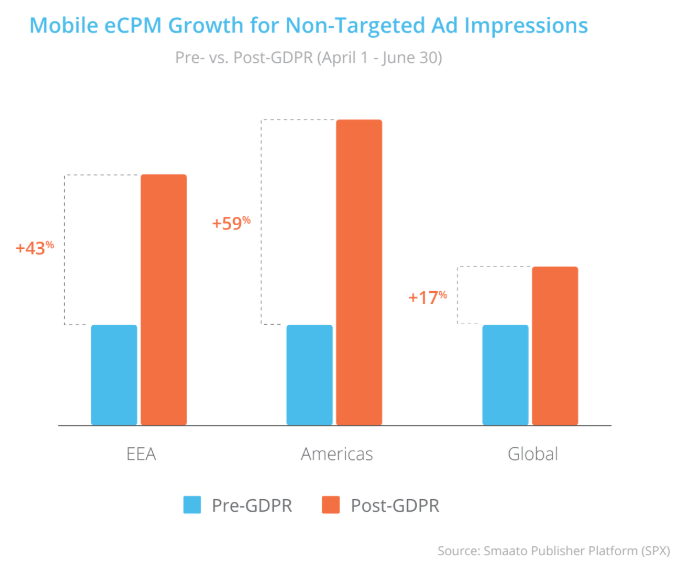Smaato report finds post-GDPR spike in CPMs for non-targeted mobile ads
Spending for targeted ads to users who have granted consent are also spiking, but the expectation is that rates will stabilize as the audience of consenting users grows.

Whatever the long-term effects of the General Data Protection Regulation (GDPR), the short-term effects include a boost in effective CPMs for non-targeted mobile ad inventory.
That’s a key finding in a recent report from mobile ad platform Smaato, “Global Trends in Mobile Advertising,” based on trillions of ad requests through its platform. In the Americas, for instance, prices for non-targeted ad impressions increased 59 percent in the period from April 1 to June 30, which includes the May 25 implementation launch for GDPR.
Why would rates for inventory of publishers in the Americas — mostly premium US publishers — increase because of GDPR? In their immediate response to the new regulation, US publishers pulled back inventory targeted at users’ data, especially for users with European IP addresses or with unknown origination. GDPR applies to any European Union visitors, regardless of where the publisher is.
At the same time, US advertisers similarly pulled back from targeted inventory that wasn’t yet consent-certified, and they gravitated toward non-targeted inventory. This increased the demand for premium US non-targeted inventory, thus raising prices.
About 90 percent of Smaato’s data relates to in-app ads, with the remainder being mobile web ads. Although the report has been issued over several years as an indicator of trends in mobile ads, this is the first time it has reported GDPR-related info.
President Arndt Groth told me that Smaato’s “non-targeted ads” are not directed at individuals’ profiles or at audience segments, but offer the same ads to every visitor or to every visitor viewing certain content.

The non-targeted rates will probably go down, he said, as the number of visitors who have provided GDPR-valid consent continues to grow, thus increasing the availability of consent-valid targeted inventory.
Groth estimates that about 75 to 80 percent of mobile users are granting GDPR-valid consent when requested. Although many publishers and advertisers had feared very low consent rates, Smaato’s experience — like publishing/marketing platform Purch and ad/measurement platform Quantcast –indicate that initial consent rates are well over 50 percent.
At the moment, there isn’t that much inventory with consent-granting users, but, for what does exist, Smaato has found a 6.5X increase in daily ad spending.
Smaato also reported that, in a recent post-GDPR survey it conducted of 300 US marketers, 55 percent said that they were “more inclined” to conduct their advertising business in programmatic guaranteed and private marketplaces instead of open exchanges, because of concerns about data protection.
Contributing authors are invited to create content for MarTech and are chosen for their expertise and contribution to the martech community. Our contributors work under the oversight of the editorial staff and contributions are checked for quality and relevance to our readers. MarTech is owned by Semrush. Contributor was not asked to make any direct or indirect mentions of Semrush. The opinions they express are their own.
Related stories